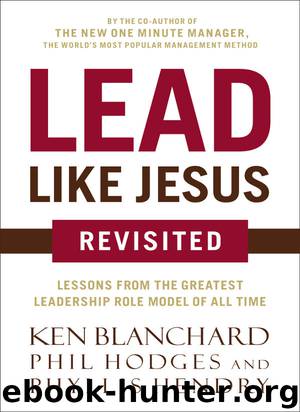Lead Like Jesus Revisited: Lessons from the Greatest Leadership Role Model of All Time by Blanchard Ken & Hodges Phil

Author:Blanchard, Ken & Hodges, Phil
Language: eng
Format: epub
Publisher: Thomas Nelson
Published: 2016-04-18T16:00:00+00:00
ESTABLISHING GOALS
Once your vision is set, you can then establish goals to answer the question What do you want people to focus on now? A compelling vision gives goals real significance.
As we said earlier, don’t have more than three to five main goals. This way you will be able to focus on the goals you think will make the biggest difference in fulfilling your vision.
An important part of goal setting is making sure everyone knows what good behavior looks like. Anyone who has attempted to get a teenager to pick up his or her room knows the general instruction “Clean up your room” is not effective. When you go back two hours later, the teen is standing proudly in the middle of a four-foot-square clean zone surrounded by undisturbed chaos, claiming proudly to have done what you asked.
Sometimes in the haste of the moment, leaders conclude for the sake of personal convenience that they have been perfectly clear about what they want in their initial instructions, and then hold their listeners accountable for perfect comprehension, perfect retention, and perfect execution. Serving people well as a leader means testing for understanding—and repetition, repetition, repetition. Great leaders almost become like third-grade teachers.5 They communicate their vision, values, and goals over and over and over again until people get them right, right, right!
PAUSE AND REFLECT
What’s your purpose? What is your preferred picture of the future? What are your values? What are your goals? If you can’t answer those questions, you don’t have a clear vision. Without a clear vision, the rest of your leadership skill and effort won’t matter.
As a leader, if you cut people loose without specific directions and well-understood guidelines, they will lose their way and the organization will suffer. Guidelines are boundaries that—like riverbanks—channel energy in a certain direction.6 If you take away the banks, there won’t be a river anymore; there will be a large puddle, devoid of momentum and direction. What keeps the river flowing are its banks.
Download
This site does not store any files on its server. We only index and link to content provided by other sites. Please contact the content providers to delete copyright contents if any and email us, we'll remove relevant links or contents immediately.
The 5 Love Languages: The Secret to Love That Lasts by Gary Chapman(8497)
The Space Between by Michelle L. Teichman(6088)
Assassin’s Fate by Robin Hobb(5237)
Wiseguy by Nicholas Pileggi(4586)
Everything Happens for a Reason by Kate Bowler(4067)
Gerald's Game by Stephen King(3918)
A Simplified Life by Emily Ley(3573)
The Power of Positive Thinking by Norman Vincent Peale(3449)
Pillow Thoughts by Courtney Peppernell(3397)
Resisting Happiness by Matthew Kelly(2887)
Girl, Wash Your Face by Rachel Hollis(2821)
Being Aware of Being Aware by Rupert Spira(2706)
Name Book, The: Over 10,000 Names--Their Meanings, Origins, and Spiritual Significance by Astoria Dorothy(2490)
Real Sex by Lauren F. Winner(2476)
More Language of Letting Go: 366 New Daily Meditations by Melody Beattie(2444)
The Holy Spirit by Billy Graham(2418)
Fast Facts on Defending Your Faith by John Ankerberg & John Weldon(2389)
Victory over the Darkness by Neil T. Anderson(2386)
The Secret Power of Speaking God's Word by Joyce Meyer(2253)
